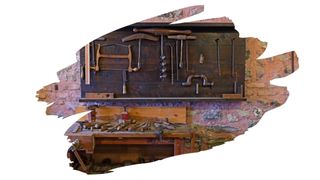With all the hard work it’ll be put through, a workbench needs a low maintenance durable finish that you can set and forget.
But, selecting the right wood finish is often easier said than done. Yet, is that still the case when it comes to a plywood workbench?
Well, in this post, you’ll learn why paste wax is the best choice finish for a plywood workbench surface — and how it can improve the usability of your workbench.
And keep reading to find out which fast-drying oil finish is ideal for that plywood surface.

This post may contain affiliate links to products that we receive a commission for (at no additional cost to you). Learn more here.
Do You Really Need To Bother Sealing A Workbench Top?
Not really. But you may need to if you’ve made that workbench using a naturally oil type of wood, such as Teak wood.
In which case, you’ll need to seal the surface, (sealing in those oils), by applying a sanding sealer.
A quality sanding sealer acts like an undercoat or pre-stain sealer. Typically, you would use it to seal over the pores of a newly sanded wooden surface. This helps prepare wood for stains and finishes.
It can also raise the grain of wood too, allowing you to sand off any raised fibers for a smoother finish. And, in the case of oily timber, the sanding sealer will seal those oils in really nicely.
Related Post: Do You Really Need To Raise The Grain Before Applying Oil?
And What Kind Of Wood Is The Best Type For A Woodworking Workbench Top?
Solid hardwood — one that is tough and naturally rot resistant — is a great choice. So, wood types such as White Oak, and even Teak wood, are good options.
Related Post: Is White Oak Good For Making Durable Outdoor Furniture?
Now, you could use Hard Maple and Beech wood too. But, while these two hardwoods are tough, they aren’t very rot resistant. So they will need to be carefully sealed to prevent decay.
What About Plywood? What Finish Is Best For A Plywood Workbench Top?
For a plywood workbench, you’ll need a finish that’s not only durable, but also good at shrugging off wood glue. You also need a finish that is fairly easy and quick to repair — especially since its going to get scratched up a lot.
So you should apply an oil finish base-coat, coupled with a top-coat of paste wax.
And What Oil Exactly Do You Use On A Plywood Workbench As The Base Coat?
Opt for a quality Teak oil product. Teak oil is made up of a blend of natural oils, varnish and thinners.
But while Teak oil is a fast-drying finish that enhances the look of wood, it isn’t all that durable on its own. Which is why — after Teak oil has dried and cured — you should top coat it with a paste wax.
Related Post: Teak Oil Not Drying? (What You Need To Know)
The reason why paste wax is a better top coat than say polyurethane, is because it makes a workbench surface incredibly smooth.
That smooth surface will make it easier for you to glide wooden boards across it. And, what’s more, paste wax is very easy to repair if it becomes damaged.
So, Teak oil will protect the wood underneath, while paste wax will give you a smooth easily repairable surface.
What About Tung Oil? Can You Use Tung Oil On Plywood Instead?
Sure you can! In fact, you can swap out Teak oil for other oil finishes, such as Boiled Linseed oil or Tung oil.
However, the problem with using Tung oil is that it cures incredibly slowly. It can take weeks for this oil to wholly cure. And you should always wait for Tung oil to completely cure before you apply paste wax over it.
Related Post: Tung Oil Not Drying? (3 Simple Ways To Fix It)
But, if you don’t mind the extra waiting time, then Tung oil will work on plywood just as well as Teak wood.
To Wrap Up, Here Are The 3 Key Takeaways From This Post…
- 1). The best type of wood for a workbench top is a tough, durable, rot-resistant hardwood, such as White Oak.
- 2). The best way to seal a plywood workbench is by applying a Teak oil base-coat. And then apply paste wax over it.
- 3). Paste wax is easy to repair. And it leaves behind a surface so smooth, that wooden boards will glide right across it.



